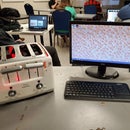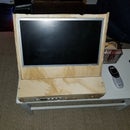Introduction: Toolbox PC
This project was made in order to make a portable low end gaming desktop that I could carry with me to LAN parties. All the parts were sourced second hand from thrift stores or friends. This solution was perfect because it only cost me about $30 to create, which is way cheaper than trying to buy a high end laptop and way easier than lugging around my heavy, expensive desktop.
Supplies
- Materials
- a cheap plastic toolbox
- desktop computer hardware
- Ram
- Motherboard with IO shield
- Processor
- hard drive
- a singular 140mm fan
- power supply
- power button
- motherboard standoffs
- zip ties
- Tools
- Drill
- Dremel (if you have it)
- Snips
- Saw or Knife
Step 1: Motherboard Mounting
The first thing I had to do was take some measurements and test all the second hand hardware to make sure it worked. The mother board booted but, I kept getting the same error message (Verifying DMI pool data). I tried all the troubleshooting steps, and could not get it to boot to any OS. Since I have another ATX motherboard that has the same dimensions, I will replace it with that when I get the chance.
The first thing I decided to put into the toolbox was the mother board. I measured the IO and cut a hole by drilling multiple holes and using snips and brute force to knock the desired section out. I cut the hole a little small in order and used a file to get it to the exact dimension. This step of cutting the toolbox could be improved by using a Dremel which would be much faster. I then drilled wholes through the bottom of the toolbox in order to mount the standoffs for the motherboard into the bottom. After the mother board was in I test fit the parts inside to get a better idea of where to mount everything. I decided to put an intake fan right about the mother board as it fit perfectly in the space between the top of the toolbox when the motherboard was mounted. I repeated the same steps as before to cut a hole to mount the fan. Also when doing this I made sure there was room for the graphics card to fit into the system with it ports still accessible. A better way to mount the graphics card would be to get a PCI-E riser and mount the graphics card flat. If you do it this way, you could also fit all the hardware in a smaller box making it more portable. The IO shield I used was a universal one that I 3-D printed and cut to size with a pair of snips. I then glued it to the side of the case using hot glue.
Step 2: Power Supply
The next thing to tackle was mounting the power supply. Since the intake fan was opposite of the power supply, I mount the power supply so that its fan would act as an exhaust. I know this isn't the best method, but I did not want to mount another fan in the case as there was not really a convenient location to put one except for maybe on top of the case which I wanted to avoid. I test fir and marked off a spot for the power supply to go and cut the hole as mentioned in the previous step. I made sure to leave plenty of space for the power supply switch and for a cable to come out the back as well. The hole that was cut is taller than in the picture to allow air to leave the toolbox. I had to mount the power supply on its side in order to make it fit. Instead of trying to guess where the screws were going to go, I decided to glue the power supply into the bottom of the toolkit. I after mounting it, I did some cable management with zip ties and made sure the computer powered on.
Step 3: SSD, Power Button, and First Power Up
The next step was to figure out what kind of storage to use and where to mount it. I had the option of either a 500GB SSD or a 2TB HDD. These were parts that I no longer needed after I upgraded my current desktop. I decided to go with the SSD as it was lighter, smaller, and there was no chance of it getting damaged from being moved around so much. I mounted it by using some double sided tape to the under side of the lid. I then ran SATA and power up to it from the power supply and tucked the cables on the other side of the power supply. I next wired up a power button and drilled a hole in the front of the case for the button to fit in. I used hot glue to secure it in place.
The first power up with it in the case was a success! The computer works very well and since it seems the cheap power supply fan is on full blast all the time, it works well as an exhaust fan (hopefully it doesn't kill the hardware). The toolbox shuts and latches nicely for only $9. For those interested here are the specs of the computer: gigabyte ma785gm-us2h motherboard, 4GB DDR2 RAM (maybe 1500mhz), GT 720 2GB graphics card, 1 140mm red fan, a 500 watt power supply, and a 500GB SSD. The system should run last gen titles and less graphically demanding games at playable frame rates, but as time goes on I hope to put in better second hand parts.











